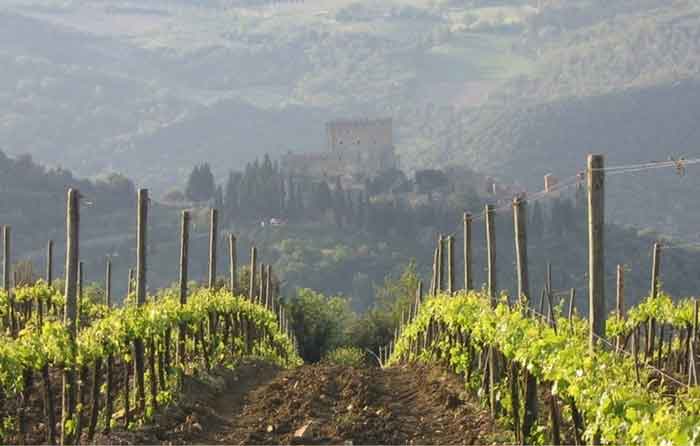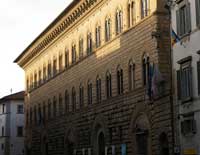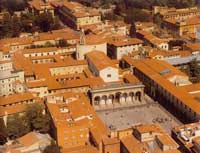| Detail of the fresco in the cupola of Santa Maria del Fiore, Florence, Italy |
Taddeo and Federico Zuccaro (Zuccari) |
| Federico Zuccari, also known as Federigo Zuccaro (c. 1540/1541 – July 20, 1609), was an Italian Mannerist painter and architect, active both in Italy and abroad. His documented career as a painter began in 1550, when he moved to Rome to work under Taddeo, his elder brother. He went on to complete decorations for Pius IV, and help complete the fresco decorations at the Villa Farnese at Caprarola. : Taddeo helped Federico win his first major commission, to paint a facade fresco in Piazza Sant'Eustachio in Rome. In this preparatory drawing, identical to the final fresco, Eustace comes across a white stag with a crucifix between its antlers, a vision that inspired his conversion to Christianity. Federico places Eustace in an angled pose through which he shares his vision with the viewer. When Federico began to execute the fresco, Taddeo interfered by retouching it without permission. Federico exploded and destroyed Taddeo's work; they reconciled on the understanding that Taddeo could retouch Federico's drawings and cartoons, but never his works in fresco, oil, or any other medium. * Decoration of the Casina Pio IV, Rome Another picture in the same collection appears to be a replica of his painting of the "Allegory of Calumny", as suggested by Lucian's description of a celebrated work by Apelles; the satire in the original painting, directed against some of his courtier enemies, was the immediate cause of Zuccari's temporary exile from Rome. Zuccari was recalled to Rome by Pope Gregory XIII to continue in the Pauline chapel of the Vatican. He visited Brussels, and there made a series of cartoons for the tapestry-weavers. In 1574 he passed over to England, were he received commission from Robert Dudley, Earl of Leicester to portray himself and Queen Elizabeth. He also painted Mary, Queen of Scots, Sir Nicholas Bacon, Sir Francis Walsingham, Lord High Admiral Howard. He painted a portrait of a Man with Two Dogs, in the Pitti Palace (Florence), and the Dead Christ and Angels in the Galleria Borghese (Rome). In 1585, he accepted an offer by Philip II of Spain to decorate the new Escorial at a yearly salary of 2,000 crowns. He worked at the palace from January 1586 to end of 1588, when he returned to Rome. His paintings (like those of El Greco before him) were disliked by Philip II and many were painted over. However the parting was amicable: "We must not blame him, but those who sent him to us", said Philip.He was succeeded by Pellegrino Tibaldi. He there founded in 1595, under a charter confirmed by Pope Sixtus V, the Accademia di San Luca, of which he was the first president. Bartolomeo Carducci is said to have studied with him.Like his Giorgio Vasari a generation before, Zuccari aimed at being an art critic and historian. His chief book, L'idea de' Pittori, Scultori, ed Architetti (1607), was far less popular.
|
|
||
Detail of the fresco in the cupola of Santa Maria del Fiore, Florence, Italy |
||
| cene from the Last Judgment, Study for the Fresco Decoration of One of the Segments of the Cupola of the Cathedral of Santa Maria del Fiore in Florenc | ||
|
||
|
||
|
||
|
||
Drawings |
||
|
||
Federico ZUCCARO (Sant'Angelo in Vado, circa 1540/41-Ancona, 1609) Allegory of the Vices Between 1574 and 1578 |
||
|
||
| The biographer and painter Giorgio Vasari noted that Taddeo Zuccaro drew "particularly the works by the hand of Raphael that were in the house of Agostino Chigi [the Villa Farnesina] and in other places in Rome. And since very often, when the evening came on, he had no other place wherein to sleep, many a night he took refuge under the loggia of the above-named Chigi's house and in other suchlike places. "Under the light of a crescent moon, Taddeo carefully copies Raphael's frescoes in the arches of the loggia above. Like other young artists of his day, he was eager to educate himself by copying the modern masters. Federico Zuccaro so carefully reproduced these designs that scholars can identify the scenes as Jupiter and Cupid and Psyche Reaching the Palace of Venus. At left, Taddeo lies exhausted, having fallen asleep while drawing. | Taddeo Copying Raphael's Frescoes in the Loggia of Villa Farnesina, Where He Is Also Represented Asleep Federico Zuccaro |
|
|
||
| After Michelangelo and Raphael, the Art of Renaissance Rome was perhaps best defined by the work of two brothers Taddeo and Federico Zuccaro. Not only were they among the most highly sought after artists of their generation, they were also a major influence behind the creation of the first art academies in Europe. Through early struggles of their own, the Zuccaro brothers developed a particular interest in the training and wellbeing of other young artists who had come to Rome to learn the art of "disegno" and even made plans to found a special refuge in the Eternal City for deserving students who arrived there with no place to live. This sheet of studies for Taddeo's frescoes in the Frangipani Chapel is one of his most momentous surviving drawings. A large figure study in red wash dominates the sheet, with several thumbnail sketches distributed around it. Red wash was an unusual technique for the period, and Taddeo used it with great effectiveness. |
Federico Zuccari, Pen and brown ink, brush with brown and red wash, and red chalk, The Art Institute of Chicago |
|
Taddeo Zuccaro Italian, 1529-1566 Three Figures Supporting a Man, Smaller Sketch of the Same, and Studies for the Blinding of Elymas, c. 1558 |
||
| This drawing is a preparatory study for a ceiling fresco in the Frangipani Chapel in San Marcello al Corso, Rome, the decorations of which were executed by Taddeo Zuccaro between 1558 and 1566, the year of the artist's premature death. Typical of his graphic style is the animated, fluid contour line and the rich combination of media. The densely packed composition and the exaggeratedly posturing, broad-hipped figures exemplify the Mannerist style that dominated Roman painting in the second half of the sixteenth century and of which Taddeo was a leading proponent. | ||
[1] |
||||
|
||||
|
This article incorporates material from the Wikipedia article Federico Zuccari published under the GNU Free Documentation License.
|
||||
 |
||||
| Discover the exellent wines in southern Tuscany | ||||
The Maremma is renowned for its culinary and wine traditions. Experience the best of Tuscany on day tours to Montalcino, Montepulciano, Scansano and the surreal beauty of the Val D'Orcia.
|
||||
|
||||
Palazzo Medici Riccardi, Florence |
Piazza della Santissima Annunziata in Florence |
Florence, Duomo |
||



